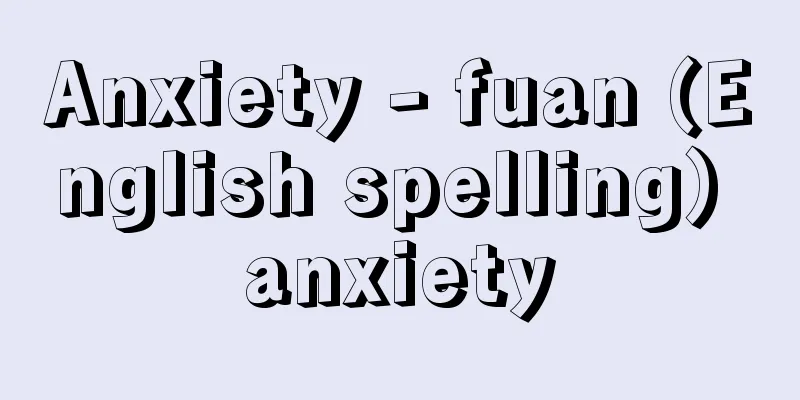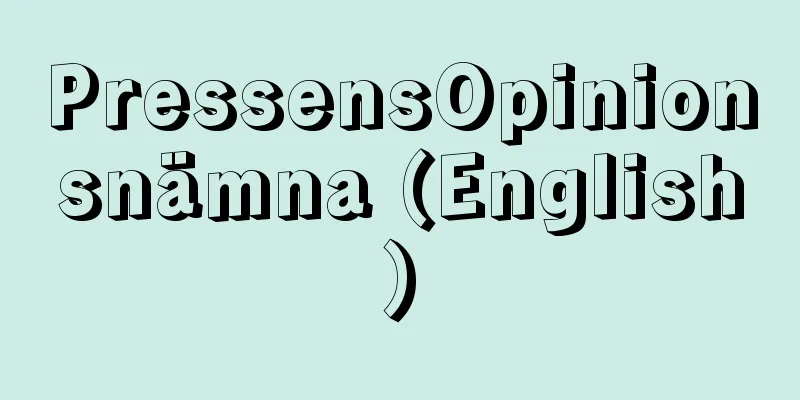Anxiety - fuan (English spelling) anxiety

|
Anxiety is a mental reaction experienced by everyone as a crisis of the ego when they sense a vague, unspecified, and ambiguous threat in their daily lives, and is a psychological state accompanied by a sense of uncertainty and helplessness. However, the meaning, content, degree, and manifestation expressed by the word anxiety are diverse. Anxiety is a subjectively experienced phenomenon, as well as a measurable physiological response that occurs at various levels in multiple systems within the body, and at the same time, it is a verbal and non-verbal objective behavioral response that can be observed by a third party. [Psychopathology of Anxiety] Anxiety has a wide spectrum, from normal to pathological anxiety. Feeling anxiety itself is not abnormal; it warns of dangers and threats before they occur and acts as a source of defensive behavior in preparation for them. In this sense, it is an important psychological state that humans possess rationally, and can be considered a power. In contrast, pathological anxiety occurs without a clear reason and causes great distress. If it persists for a long time and begins to interfere with daily life, it can develop into a mental illness known as anxiety disorder. The first theoretically systematized concept of anxiety was psychoanalytic anxiety by Freud, S. In 1926, from a psychoanalytic perspective, he distinguished anxiety into realistic anxiety and neurotic anxiety in his book The Problem of Anxiety (Hemmung, Symptom und Angst). Realistic anxiety (Realitätangst) is an internal reaction to potentially anticipated harm or psychological distress caused by a phenomenon whose source of threat is in the external world of the individual. In contrast, neurotic anxiety (neurotische Angst) is anxiety caused by internal impulses within the individual. Psychoanalysis believes that most of the mind is made up of the unconscious world. The deepest region of the mind is the id. In the id, impulses are generated by hedonistic desires known as libido. The super-ego, located at the top of the mind, attempts to suppress these impulses, and conflict arises between it and the id. This creates tension in the ego region between the id and super-ego, as the id pushes up and the super-ego tries to suppress it. The ego attempts to make this adjustment, but if the adjustment is not successful, it is thought that a sense of unity of the self is lost and neurotic anxiety arises. In many cases, an individual's internal impulses are repressed in a layer of the unconscious that the individual is usually not aware of, so even if the individual feels neurotic anxiety, he or she does not know where it is coming from or what the cause is. When events or memories that are threatening to the individual frequently come to consciousness, the individual's existence becomes threatened. Therefore, it is hypothesized that a psychological defense mechanism called repression is activated, which tries to push the immediate problem into the unconscious world in order to prevent anxiety from arising. For this reason, if these impulses continue to accumulate, neurotic anxiety can turn into hysteria and be transformed into physical symptoms (for example, paralysis or pain in the limbs), or strong repression can develop into dissociative symptoms such as a split in the ego or memory loss, or it can become strong emotional tension such as conflict, which manifests as restless reactions such as irritation or impatience for no reason. In psychoanalysis, it is believed that the mechanism behind the development of neurosis is related to this anxiety and repression. Based on Freud's concepts of realistic anxiety and neurotic anxiety, Spielberger, C. (1972) modeled the mechanism of anxiety generation and classified anxiety into state anxiety and trait anxiety. As shown diagrammatically in Figure 1, state anxiety is a transient anxiety state that is evoked when a situation is cognitively appraised as threatening, and occurs situation-dependently in that it is caused by the situation. In contrast, trait anxiety is an anxiety tendency that a person has as a personality trait that makes them prone to anxiety, and the manifestation of anxiety originates from an individual's personality traits. When it is difficult to clearly determine whether an external stimulus is threatening or not, people tend to recall past memories (internal stimuli) or intuitively judge the stimuli based on their everyday thinking habits and beliefs. In other words, the information of the stimulus is processed (cognitive evaluation) through one's own experiences and cognitive frameworks. People with high trait anxiety tend to overreact strongly to trivial and ambiguous stimuli. Cognitive evaluation is actively triggered, and such stimuli are clearly and definitively processed as threatening, resulting in state anxiety. If the person can successfully deal with the external stimulus that is judged to be threatening, state anxiety will decrease and psychological stability can be restored (adaptation state). While Freud hypothesized that defense mechanisms operate at an unconscious level, Spielberger hypothesized that defense mechanisms operate at an intentional (conscious) level. As shown in Figure 1, defense mechanisms are considered to be processes that create an adaptive state to avoid or reduce state anxiety that arises as a result of cognitive evaluation. The Japanese version of Spielberger's State-Trait Anxiety Inventory (STAI), which assesses state and trait anxiety, respectively, was standardized by Mizuguchi Kiminobu et al. (1991). Later, Spielberger's view of anxiety, which emphasizes cognitive appraisal, had a strong influence on Lazarus, R.S. and Folkman, S. (1984)'s transactional model of stress (described below), and was theoretically refined by Mandler, C. (1984), Wells, A. and Matthews, G. (1994), to treat anxiety as an anticipatory response elicited in response to a threatening situation, and as a personal evaluation, interpretation, and explanation of a situation such as concern, in other words, cognition. On the other hand, from the viewpoint of emphasizing learning, anxiety and fear are considered to be conditioned responses to pain or unpleasant sensations through the mechanism of classical conditioning (or respondent conditioning) discovered by Pavlov, IP (1927). Furthermore, it has been empirically proven that anxiety conditioned in this way exerts its power as a learned drive that motivates responses to escape from threatening stimuli when aversive stimuli are expected, or forms behaviors to prevent or avoid their occurrence. This mechanism is the result of negative reinforcement of operant behavior conditioning (or instrumental conditioning) discovered by Skinner, BF (1938), and explains how aversion learning of escape and avoidance responses is established through fear and anxiety. Various treatments such as exposure therapy and systematic desensitization, which are clinically effective for anxiety disorders and other mental illnesses, have been developed through such verification. The current hypothesis regarding the neural basis of the brain mechanism of anxiety has been proposed based on the pharmacological analysis of anxiolytic drugs. The fact that many anxiolytic drugs have a stimulatory effect on γ-aminobutyric acid (GABA) A receptors (benzodiazepine derivatives) and serotonin (5-hydroxytryptamine, 5-HT) receptors (fluoxetine, azaspirone, etc.) suggests that dysfunctions mediated by both the GABAergic and 5-HTergic systems may play a role in anxiety disorders. In addition, changes in noradrenaline (NA) nervous system activity in the brain of rats placed under anxiety-inducing psychological stress situations, such as fear conditioning or the presentation of uncontrollable electric shocks, have been examined from the perspective of neurotransmitter release and metabolism, with a decrease in NA content in the hypothalamus and amygdala and an increase in the content of 3-methoxy-4-hydroxyphenylethylene glycol sulfate (MHPG- SO4 ), the main metabolic product of NA after it is released into the synaptic cleft. It has been known that the NA nervous system is closely related to emotions such as anxiety. When anxiety is evoked, NA release is significantly increased in the locus coeruleus, which is the cell body of NA, and in the hypothalamus, amygdala, hippocampus, and other nerve terminals, resulting in a decrease in NA content and an increase in MHPG-SO 4 content. At the very least, there is no doubt that the NA nervous system in the limbic system relays the onset and expression of anxiety. Another study investigating brain structures related to anxiety disorders also pointed out that the amygdala plays a major role in fear and defensive behavior. Findings supporting the involvement of the amygdala in the formation and expression of anxiety include, first, that the amygdala has a high concentration of GABA A receptors, and that local injection of benzodiazepines into the amygdala reduces anxiety in animals, and second, that injection of a GABA A receptor antagonist into the amygdala prevents the anti-anxiety effect from being expressed, even when benzodiazepines are administered systemically. On the other hand, brain imaging studies of anxiety disorder patients have not yet revealed clear pathological findings in brain regions such as the amygdala that are associated with anxiety disorders. One reason for this is that average observations obtained from multiple patients as a group make conclusions unclear. The amygdala, hypothalamus, and hippocampus of the limbic system play an important role in the expression of anxiety and fear. This can be seen from the fact that when an external stimulus is input to the amygdala via the thalamus and the amygdala judges the external stimulus to be dangerous, neurotransmitters such as NA, 5-HT, dopamine, and γ-GABA are released. The release of these neurotransmitters causes an exaggerated awareness of physical reactions, and when this peripheral internal information is fed back to the thalamus-amygdala, an anxiety system in the brain linked to physical reactions is formed. For example, anxiety is known to be associated with decreased activity of the 5-HT nervous system. 5-HT is a neurotransmitter produced from the essential amino acid tryptophan, and it regulates the secretion of other neurotransmitters such as NA and has a stabilizing effect on the mind. In individuals with severe anxiety symptoms or chronic stress, the secretion of 5-HT is decreased, and the final metabolic product, 5-HIAA (5-hydroxyindoleacetic acid), is also decreased. Selective 5-HT reuptake inhibitors (SSRIs), which are widely used as new antidepressants, are effective in improving the symptoms of generalized anxiety disorder (GAD) and panic disorder, suggesting that decreased activity of the 5-HT nervous system is involved in the development of anxiety disorders. Biological studies of GAD patients have shown that NA receptors are oversensitive even when basal levels of NA and cortisol are within the normal range. GAD symptoms worsen under stressful conditions. It is thought that the increased response of the hypothalamic-pituitary-adrenal (HPA) axis and the hypothalamic-sympathetic-adrenal (SAM) axis to stress causes GAD patients to pay attention to the negative aspects of external information and to have negative cognitive distortions about their ability to cope (i.e., lack of self-efficacy). Regarding panic disorder, it has been pointed out that when a person with an overactive NA nervous system is triggered by insomnia or psychological stress (anger, worry, or distress), a switch that increases anxiety is flipped, resulting in a panic attack. It is speculated that the intense experience of this first panic attack sustains hyperactivity of the NA nervous system in the limbic system, such as the amygdala, making it easier to cause the next attack. In recent years, it has become known that psychiatric disorders such as anxiety disorders and depression are manifested by interactions between genes and the environment. Patients who have relatives with anxiety or mood disorders are more likely to develop anxiety or mood disorders due to the influence of life events. Even in the same environment, the influence of life events on disorders such as anxiety disorders differs depending on the presence or absence of genes associated with vulnerability. Recently, the relationship between anxiety and the 5-HT transporter (5-HTT) gene, which contains genetic information related to the neurotransmission of 5-HT, has been investigated. 5-HTT gene polymorphisms include the l allele, which has high transcriptional activity, and the s allele, which has low transcriptional activity (the term allele refers to the composition of various alleles). In individuals with strong anxiety, such as those with neurotic tendencies or a tendency to avoid harm, the frequency of s-allele expression is high, so it is possible that differences in the frequency of 5-HTT gene polymorphism may determine the expression of anxiety symptoms. In addition, there are racial differences in the frequency of l-allele and s-allele expression, with the s-allele being more prevalent among Japanese people. [The social pathology of anxiety and stress] The phenomena of anxiety and stress are very similar. Anxiety is one of the main stress responses, but it can also act as a cause of stress (called a stressor). In modern society, the causes of psychological and social stress, such as interpersonal problems, excessive work burdens, economic anxiety, and illness, are increasing, and the social pathology of anxiety is widespread throughout society. According to Selye, H. (1936), stress is a concept that collectively represents the demands placed on the adaptability of the mind and body and the state of mental and physical tension caused by those demands. The former demands placed on the body are defined as stressors, and the latter state of mental and physical tension is defined as stress responses. The awareness of stress, like anxiety, is a mental phenomenon commonly experienced in our daily lives as pressure or threat, and also manifests as a physical and behavioral phenomenon accompanied by various physiological changes such as muscle tension, heartbeat, restlessness, etc. This can be understood from the fact that the two typical stress response axes are the hypothalamic-pituitary-adrenal cortex (HPA) axis and the hypothalamic-sympathetic-adrenal medulla (SAM) axis, which are responsible for the expression of anxiety. Psychological research on stress began with Holmes, TH et al.'s (1967) study of the Social Readjustment Rating Scale based on the Life Events Measurement. They defined stress as the experience of events that occur in daily life, such as the death of a spouse or marriage, and the amount of energy required to recover from those changes. However, this approach has been criticized for not being able to adequately explain individual differences in stress, and for the fact that the more significant stressors are minor irritations and chronically persistent confusions and worries in everyday life that depend on the recipient's cognition (for example, daily hustles such as human relationships, housework, and caring for family members). In this respect, stress, like the manifestation of anxiety, exists psychologically in the interaction between the individual and the situation. The following five causes of stress are assumed, which share the same nature as the manifestation of anxiety: (1) When a situation is important to oneself, is expected to have a significant impact, and one feels the need to commit to it; (2) When a situation exceeds one's ability to understand, cannot be interpreted or explained, and a state of cognitive dissonance continues; (3) When one feels that the situation is too complex and powerful for one's own power to handle (control), and cannot be easily resolved or escaped; (4) When one thinks that it is difficult to calm down on one's own the heightened state of arousal caused by a threat; (5) When one thinks that one's reevaluation of the results after actually experiencing the situation remains the same or worsens, and so on. Currently, the most influential model to psychologically explain the mechanism behind stress is the transactional model proposed by Lazarus and Volkman (1984), which emphasizes cognitive appraisal and coping with stressors (Figure 2). This model considers stress to be a dynamic process of coping, that is, a relationship cognitively appraised as stressful in the interactive negotiation between an individual and the environment, and conscious efforts to counteract that stressful relationship. According to the transactional model, the first stage of cognitive appraisal is the primary appraisal stage. We judge whether a stressor is irrelevant, acceptable, or stressful. If a stressor is appraised as threatening to well-being, it becomes a threat, harm, or something to be challenged, evoking a stressful situation characterized by unpleasant feelings or emotions such as anxiety. In the second appraisal stage, the patient considers his/her own response to the stressful situation and the underlying stressor. To overcome the situation, available coping strategies are determined from existing coping resources. The choice and implementation of coping strategies are determined by the nature of the stressor (e.g., whether it is controllable or predictable) as well as the individual's belief and value system, including personal characteristic factors (e.g., self-efficacy, locus of control, optimistic personality tendency, availability of social support, etc.). Therefore, it is not possible to predict in general terms how and when a person will deal with a particular stressor. This is why it is said that effective coping lies in the flexibility to use a variety of optimal strategies in a timely manner depending on the nature of the stressor and the difference in the situation. For example, when adopting a certain coping strategy, the coping strategy is selected and implemented after forecasting "what kind of outcome will occur" and "whether the actions to achieve that outcome can be successfully carried out." Coping strategies are broadly divided into two types: problem-focused coping, which aims to change or resolve the threatening situation itself, and emotion-focused coping, which aims to control the unpleasant emotions caused by the threatening situation. In the final stage, reappraisal, the coping strategy against the stressor is reevaluated to determine whether it was successful or not. The emotions that arise as a result of the failure of the coping strategy are anxiety and fear as stress responses. The impact of stressors on the mind and body varies depending on the individual's response, such as how they perceive the stressor and how they deal with it. In other words, the conditions that cause stress are not necessarily absolute, but arise from an imbalance between the demands of the environment as a stressor and the individual's coping resources. This suggests that what is stressful for one individual may not be so for another. In the stress-coping process, awareness of personal control (whether one can effectively deal with a stressor) is important as a major factor in determining whether a situation is stressful or not. For example, even if one is exposed to the same stressor, it is known that not only will the choice and strategy of coping with the stressor be different when one expects or judges it to be controllable, but the resulting stress response will also be significantly different. In general, when a stressful situation is perceived as controllable, problem-focused coping increases, and when it is judged to be uncontrollable, emotion-focused coping tends to be used. The expectation of control over threats is also useful in explaining the difference between anxiety and fear. When we do not have effective means to deal with a threat and cognitively evaluate the situation as uncontrollable, we develop a state of anxiety dominated by apprehension. On the other hand, fear is an emotion of concern about a specific threat or danger that warns us of safety, such as heights or snakes, and thus motivates active coping to escape or avoid the situation. This motivation by fear is more likely to occur when the organism expects the situation to be somewhat controllable, but when such coping fails, the situation is perceived as uncontrollable, resulting in anxiety. If coping with the threat is ineffective and the uncontrollable situation continues for a long time, the person will fall into an even more helpless state and anxiety will turn into depression. This suggests that negative emotions are a highly pervasive spectrum that underlies anxiety disorders and mood disorders, which is of interest from the perspective of clinical psychology. In recent years, physical illnesses caused by stress have been receiving increasing attention. In particular, it has been pointed out that stress is closely related to the onset and aggravation of lifestyle-related diseases. Lifestyle-related diseases are defined as "a group of diseases whose onset and progression are related to lifestyle habits such as eating habits, exercise habits, rest, smoking, and drinking," and representative examples include hyperlipidemia, diabetes, hypertension, ischemic heart disease (myocardial infarction, angina pectoris), cerebrovascular disorders, and malignant tumors. It is assumed that there are three routes by which stress affects the onset, progression, and recurrence of lifestyle-related diseases. The first, behavioral route, is because accumulated stress makes it difficult to practice desirable health behaviors. Not getting enough rest leads to lack of sleep and accumulated fatigue, and health risk behaviors such as excessive drinking and smoking, unbalanced eating habits, and lack of exercise increase, which can lead to obesity, insulin resistance, and arteriosclerosis, which can cause metabolic syndrome (visceral fat syndrome), and increase the risk of developing lifestyle-related diseases. The second physiological route involves the reactivity and recovery of the body's regulatory systems, including the nervous system, endocrine system, and immune system, as a stress response. Physiological changes caused by stress induce an allostatic response (a change that attempts to maintain stability while the multiple systems of the body fluctuate) as a psychoneuroendocrine-immunological response in the body's regulatory systems. However, if this arousal occurs excessively and frequently (this is called allostatic load), the allostatic response breaks down, which ultimately leads to the onset or worsening of various physical illnesses. The third emotional route is mediated by unpleasant or negative emotions such as anxiety and depression. If these emotions or feelings continue excessively for a long period of time, they can lead to anxiety disorders or mood disorders (such as depression and dysthymia). They also increase the risk of developing lifestyle-related diseases. It is said that one in five patients with lifestyle-related diseases also suffer from anxiety or mood disorders. This leads to a vicious cycle in which lifestyle-related diseases themselves cause stress, which in turn induces anxiety and fear. In this way, excessive stress has a significant impact on mental and physical health, and is closely related to important health issues in Japan today, such as lifestyle-related diseases, anxiety disorders, depression, and even an increase in suicides. In today's society, which is undergoing rapid and complex change, the causes and triggers of anxiety, as well as stress, will only increase, not decrease. In the future, anxiety research is expected to develop in cooperation with adjacent fields of psychology, while also intertwining with the issue of stress. → Psychoanalysis → Social anxiety → Anxiety-related disorders [Hisamasa Okamura and Akira Tsuda] (Akira Tsuda and Yoshiyuki Tanaka, "Psychology," edited by Eiichiro Niki, "The Science of Stress and Health," Kyoritsu Shuppan, 2008, with some modifications) Figure 2. Lazarus and Volkmann's strike... (Spielberger, 1996, Hideki Ohira, "Emotions" edited and supervised by Fumio Yamada, "Minimum Psychology for Medical Behavioral Sciences", Kitaoji Shobo, 1997) Figure 1 Spielberger's state-trait anxiety... Latest Sources Psychology Encyclopedia Latest Psychology Encyclopedia About Information |
|
不安は,日常生活の中で,漠然とした特定できない曖昧な脅威を察知したときに,自我の危機としてだれもが経験する心的反応であり,不確定性と無力感を伴う心理的状態である。しかし,不安ということばによって表現される意味と内容,程度,現われ方は多様である。不安は主観的に体験される現象であるとともに,生体内の多システムのさまざまなレベルで生じる測定可能な生理的反応でもあり,同時に第三者が観察することのできる言語的および非言語的な客観性を帯びた行動的反応でもある。 【不安の精神病理】 不安は,正常な不安から病的な不安に至るまで,幅広いスペクトラム(範囲)をもつ。不安を感じることそれ自体は決して異常ではなく,危険や脅威を未然に警告し,それらに備えて防御するための行動の源泉として働く。この意味で,人間に合理的に備わった大切な心理であり,力ともいえる。これに対して病的な不安は,明確な理由がなく生じて,苦痛が大きい。長期的に持続し,日常生活に支障をきたすようになると,不安障害anxiety disorderという精神疾患にまで発展する。 最初に理論的に体系づけられた不安の考え方は,フロイトFreud,S.による精神分析論的不安である。彼は精神分析の立場から,1926年に著書の『不安の問題Hemmung,Symptom und Angst』の中で,不安を現実的不安と神経症的不安に区別した。現実的不安Realitätangstとは,脅威の原因が個人の外界にある事象に対して,潜在的に予測される危害や心理的苦痛に対する内的反応である。これに対して,神経症的不安neurotische Angstとは,個人内の内的衝動によって引き起こされる不安である。 精神分析では,心のほとんどが無意識世界から成り立っていると考える。いちばん奥深い心の領域は,イドidである。イドでは,リビドーとよばれる快楽的な欲求によって衝動が生じる。心の上部にある超自我super-egoはそれらの衝動を抑えようとして,イドとの間に対立が起こる。すると,イドと超自我との間にある自我egoの領域に,イドからの突き上げと超自我からの抑え込みによって緊張が生じる。 自我はこの調整を試みるが,調整がうまく行なわれないと,自己の統一感を喪失して神経症的不安が生まれると考えられる。個人の内的衝動は,多くの場合,通常は本人が意識できない無意識の層の中に抑圧されているため,神経症的不安を感じていても,当人にはそれがどこから生じているのか,その原因がわからない。自分にとって脅威となるような出来事や記憶がひんぱんに意識に上がってくると,自分の存在が脅かされるようになる。そこで,不安を生じさせないようにするために,当面の問題を無意識の世界に押し込めようとする,抑圧repressionの心的な防衛メカニズムが働くと仮定した。 このため,それらの衝動が蓄積されつづけると,神経症的不安はヒステリーhysteriaとなって,身体症状として転換されてきたり(たとえば,手足の麻痺や痛みなど),強い抑圧が自我の分裂とか記憶喪失などの解離性症状に発展したり,葛藤などの強い感情的緊張となって,理由もなくイライラしたり,焦ったりするなどの落ち着かない反応として顕在化することとなる。精神分析では,神経症を発症するメカニズムがこの不安と抑圧に関連していると考えられている。 フロイトの現実的不安と神経症的不安の概念を踏まえて,スピールバーガーSpielberger,C.(1972)は,不安発生のメカニズムをモデル化し,不安を状態不安state anxietyと特性不安trait anxietyに分類した。図1に模式的に示すように,状態不安は,状況を脅威的なものと認知的評価したときに喚起される一過性の不安状態であり,状況が原因となって発現する点で,状況依存的に生じる。これに対して,特性不安は,その人が元来,不安を感じやすい性格的なものとして有している不安傾向であり,不安の発現が個人の性格特性に由来している。 外的刺激が脅威的かそうでないか明確に断定しにくい場合ほど,過去の記憶を想起したり(内部刺激),日頃の考え方のくせや信念に基づいて,それらの刺激を直感的に判断したりする。つまり,自分の経験や認知の枠組みを通して,刺激の情報処理(認知的評価)が行なわれる。特性不安の高い人は,ささいで曖昧な刺激に対して,強く過剰に反応しやすい。認知的評価が積極的に発動され,そのような刺激を脅威なものとして明確に断定的に処理してしまう結果,状態不安を感じてしまう。もし,脅威と判断された外的刺激にうまく対処できれば,状態不安は低減し,心理的な安定を取り戻すことができる(適応状態)。 フロイトが無意識水準で防衛機制が作用すると仮定したのに対して,スピールバーガーは意図的水準(意識水準)で防衛機制defense mechanismが働くことを仮定している。図1に示すように,防衛機制は,認知的評価の結果生じた状態不安を,回避もしくは低減するための適応状態を生み出すプロセスとして考えられている。状態不安と特性不安をそれぞれ評価するスピールバーガーの状態・特性不安インベントリーstate-trait anxiety inventory(STAI)の日本版は,水口公信ら(1991)によって標準化されている。 その後,スピールバーガーの認知的評価を重視する不安の考え方は,ラザラスLazarus,R.S.とフォルクマンFolkman,S.(1984)のストレスのトランスアクショナル・モデル(後述)に強い影響を与えるとともに,マンドラーMandler,C.(1984)やウェルズWells,A.とマシューズMatthews,G.(1994)によって理論的に洗練されて,脅威事態に対して喚起された予期反応として,また懸念といった事態についての個人的な評価,解釈,説明,すなわち認知cognitionとして扱われている。 一方,学習を重視する立場から,不安と恐怖がパブロフPavlov,I.P(1927)によって発見された古典的条件づけ(または,レスポンデント条件づけ)のメカニズムによって,苦痛や不快感に条件づけられた反応であると考えられている。さらに,このようにして条件づけられた不安は,嫌悪刺激が予想される脅威的状況において,その刺激から逃避する反応を動機づけたり,その生起を未然に回避したり,阻止する行動を形成させる学習性動因としての力を発揮することも実証的に証明されている。 このメカニズムは,スキナーSkinner,B.F.(1938)が発見したオペラント行動の条件づけ(または,道具的条件づけ)の負の強化によるもので,恐怖と不安を媒介として逃避・回避反応の嫌悪学習が成立していることを説明している。不安障害などの精神疾患に対して,臨床的に有効性の高いエクスポージャーや系統的脱感作法などの治療法が,このような検証を経てさまざま生み出されている。 現在の脳の不安系システムbrain mechanism of anxietyの神経基盤に関する仮説は,抗不安薬の薬効分析に基づいて提唱されている。多くの抗不安薬が,γ-アミノ酪酸(GABA)A受容体(ベンゾジアゼピン系誘導体)やセロトニン(5-hydroxytryptamine,5-HT)受容体(フルオキセチン,アザスピロン系など)に促進的に作用するという事実は,GABA神経系と5-HT神経系を介する双方の機能異常が,不安障害において一定の役割を果たしている可能性を示唆している。 また,恐怖条件づけやコントロール不可能な電撃の呈示など,不安が喚起されるような心理的ストレス状況下におかれたラット脳内のノルアドレナリンnoradrenaline(NA)神経系活動の変化についても,神経伝達物質の放出と代謝という観点から,視床下部や扁桃体のNA含量の低下とシナプス間隙に放出された後のNAの主要代謝産物である3-methoxy-4-hydroxyphenylethylene glycol sulfate(MHPG-SO4)の含量の増加が検討されている。 これまでNA神経系は,不安などの情動と密接に関係していることが知られている。不安が喚起されると,NAの細胞体である青斑核をはじめ,その神経終末部位である視床下部,扁桃体,海馬などで,NA放出亢進が顕著に起こり,結果としてNA含量の低下とMHPG-SO4含量が上昇する。少なくとも,不安の発現や表出に大脳辺縁系のNA神経系が中継していることは間違いないだろう。 不安障害に関連する脳構造を調べた別の研究でも,扁桃体amygdalaは恐怖と防御行動に主要な役割を果たすことが指摘されている。不安の形成と発現に扁桃体が関与していることを支持する知見として,第1に扁桃体はGABAA受容体の濃度が高く,扁桃体へのベンゾジアゼピン系薬の局所注入は動物の不安を軽減すること,第2に扁桃体にGABAA受容体の拮抗薬を注入すると,ベンゾジアゼピン系薬を全身的に投与しても,抗不安薬の効果発現が生じないことが挙げられる。 一方,不安障害患者の脳イメージング(画像)研究では,扁桃体などの脳部位において,不安障害と関連づけられるような明確な脳構造の病理的な知見はまだ明らかではない。その一つの理由として,複数の患者から得られたグループとしての平均的な観察結果が,結論を曖昧にしていると解釈されている。 不安や恐怖の発現に関与する部位として,大脳辺縁系の扁桃体,視床下部,海馬などが重要な役割を果たしている。このことは,外的刺激が視床を介して扁桃体に入力され,扁桃体が外的刺激を危険と判断すると,NAや5-HT,ドーパミンやγ-GABAなどの神経伝達物質neurotransmitterが放出されることからわかる。これらの神経伝達物質の放出により,身体反応が過剰に自覚され,これら末梢での体内情報が再び視床-扁桃体にフィードバックされると,身体反応と結びついた脳の不安系システムが形成されることになる。 たとえば,不安は5-HT神経系活動の低下と関連していることがわかっている。5-HTは,トリプトファンという必須アミノ酸から生成される神経伝達物質であり,NAなどのほかの神経伝達物質の分泌を調節し,精神を安定させる作用を有している。不安症状の強い個人や慢性ストレス状態の人では,5-HTの分泌が減少しており,その最終代謝産物である5-HIAA(5-ヒドロキシインドール酢酸)も低下している。新規抗うつ薬として広く普及している選択的5-HT再取り込み阻害薬(SSRI)が,全般性不安障害generalized anxiety disorder(GAD)やパニック障害の症状改善に有効であることから,5-HT神経系の活動低下が不安障害の発症に関与していることが示唆されている。 GAD患者を対象とした生物学的研究では,NAやコルチゾールの基礎値は正常範囲であっても,NA受容体の過感受性が起こっていることがわかっている。GADの症状は,ストレス状況下で悪化する。ストレスに対する視床下部-下垂体-副腎皮質(HPA)系と視床下部-交感神経-副腎髄質(SAM)系の反応亢進は,GAD患者に外部情報の否定的側面への注意を促したり,対処能力についての否定的な認知的歪曲をもたらしたりする(つまり自己効力感のなさ)などとも考えられている。 パニック障害panic disorderに関しても,NA神経系が過活動状態の人に,不眠や心理的ストレス(怒り,心配や悩み)などの誘因が加わった際に,不安を高めるスイッチが入り,パニック発作が起こると指摘されている。この初回のパニック発作の強烈な経験が,扁桃体などの大脳辺縁系におけるNA神経系の機能亢進を持続させ,次の発作を引き起こしやすくするものと推測されている。 不安障害やうつ病などの精神疾患は,遺伝子と環境との相互作用によって発現することが近年知られてきた。不安障害や気分障害の近親者をもつ患者ほど,ライフイベントの影響によって不安障害や気分障害を発症しやすい。同じ環境下にあっても,脆弱性と関連した遺伝子群の有無により,不安障害などの疾患に及ぼすライフイベントの影響は異なる。 最近,5-HTの神経伝達に関係する遺伝情報が書き込まれた5-HTトランスポーター(5-HTT)遺伝子と不安との関連性が調べられている。5-HTT遺伝子多型には,転写活性が高いlアレルlong alleleと低いsアレルshort alleleが存在する(さまざまな対立遺伝子から構成されていることを,アレルalleleと称する)。 神経質傾向や危害回避傾向などの不安の強い個人では,sアレルの発現頻度が高いことより,5-HTT遺伝子多型の発現頻度の違いが不安症状の発現を規定している可能性がある。また,lアレルとsアレルの発現頻度には人種差があり,日本人にはsアレルが多いといわれている。 【不安とストレスの社会病理】 不安とストレスstressの現象は,きわめて似通っている。不安は,ストレス反応の主要な一つであるが,不安がストレスの原因(ストレッサーstressorと称する)としても作用する。現代社会では,人間関係の問題や,仕事上の過重な負担,経済的不安,病気などの心理的・社会的なストレスの原因がますます増大しており,不安の社会病理は社会の至る所で蔓延している。 セリエSelye,H.(1936)によれば,ストレスとは,心身の適応能力に課せられる要求と,その要求によって惹起される心身の緊張状態を全体的に表わす概念である。前者の生体に加わる要求はストレッサーとして,後者の心身の緊張状態はストレス反応として定義づけられている。 ストレスの自覚は,不安と同様に,われわれにとってプレッシャーや脅威として,日常的に共通に体験される精神的現象であるとともに,筋緊張や胸の鼓動,落ち着きのなさなどのさまざまな生理的変化を伴った身体的・行動的現象として現われる。このことは,二つの定型的なストレス反応軸が,不安の発現をつかさどる視床下部-下垂体-副腎皮質(HPA)系と視床下部-交感神経-副腎髄質(SAM)系であることからも理解できる。 ストレスに関する心理学的な研究は,ホームズHolmes,T.H.ら(1967)のライフイベンツ測定による社会的再適応評定尺度の研究に始まる。彼らは,配偶者の死や結婚などの日常生活の中で起こった出来事の体験とその変化からの回復に必要なエネルギー量をストレスとして定義した。しかしながら,このようなとらえ方では,ストレスの個人差が適切に説明できないこと,ストレッサーとしてより重要な意味をもつのが,受け手側の認知に依存する日常生活場面の些細ないらだち事や慢性的に持続する混乱や心配事である(たとえば人間関係,家事,家族の介護などのデイリーハッスルズ)という批判が起こった。 この点で,ストレスは不安の発現と同様に,個人と状況の相互作用のうちに心理的に存在する。ストレスが生じる原因として,次の五つが想定されているが,これらは不安の発現と性質を同じにしている。⑴事態が自分にとって重要であり,重大な影響を及ぼすと予想され,しかもそれにコミットメントする必要を感じている場合。⑵事態が自分の理解力を超えて,解釈と説明がつけられず,認知的に不協和な状態が続く場合。⑶自分の力では事態が複雑,強大すぎて,対応する(コントロール)ことが難しく,容易に解決したり,逃れられたりできないと感じている場合。⑷脅威によって高まった覚醒状態を,自力で鎮めることが容易でないと思う場合。⑸事態を実際に体験した後の結果に対する再評価が,変わらないか悪くなっていると思った場合,などいろいろある。 現在,ストレスの生じるメカニズムを心理学的に説明する最も影響力のあるモデルは,ラザラスとフォルクマン(1984)によって提唱された認知的評価およびストレッサーに対するコーピングcoping(克服)を重視するトランスアクショナル・モデルtransactional modelである(図2)。このモデルは,ストレスを,個人と環境との相互作用的な交渉の中で,ストレスフルなものとして認知的に評価された関係性と,そのストレスフルな関係性に対抗する意識的な努力,すなわちコーピングのダイナミックな過程であると考える。 トランスアクショナル・モデルによれば,認知的評価の最初は,1次的評価の段階である。自分にとって,ストレッサーは無関係なものか,受け入れやすいものか,あるいはストレスフルなものかを判断する。ここで,安寧を脅やかすものと評価されたとき,脅威,危害,挑戦すべき対象となり,不安などの不快な感情もしくは情動によって特徴づけられたストレスフルな状況が喚起される。 続く2次的評価の段階では,このようなストレスフルな状況とその基になったストレッサーに対する自分の対応を考える。その事態を克服するために,現有するコーピング資源の中から利用可能なコーピング方略が決定される。コーピングの選択と実行は,ストレッサーの性質(コントロール可能かどうか,予測可能かどうかなど)に加えて,個人的な特性要因(たとえば自己効力感やコントロールの所在,楽観的パーソナリティ傾向,ソーシャルサポートの有無など)を含む個人の信念価値体系によっても規定されている。 したがって,どのようなストレッサーに対して,どのような人がどのように,そしていつコーピングを行なうかは一概に予測できない。効果的なコーピングは,ストレッサーなどの性質や状況の違いに応じて,最適な方略をタイミングよく多様に使い分ける柔軟性にあるといわれるわけがここにある。 たとえば,あるコーピング方略を採用した際に,「どのような結果が起きるか」「その結果を導くための行動をうまく遂行できるか」という見通しを立てたうえで,コーピングが選択され,実行される。コーピングは,脅威事態そのものを変化させる,または解決することを目的とする問題焦点型コーピングと,脅威事態によって生起した不快な情動のコントロールを目的とする情動焦点型コーピングの大きく二つに分けられる。 最後の再評価の段階では,ストレッサーに対するコーピングが成功したか失敗したかについて再評価される。ここで,コーピングが失敗した結果として生じる情動がストレス反応としての不安や恐怖である。 ストレッサーの心身に及ぼす影響は,個人がストレッサーをいかに認知し,それに対してどのようにコーピングしたかといった個人の対応いかんで異なってくる。すなわち,ストレスを引き起こす条件は必ずしも絶対的なものではなく,ストレッサーとしての環境からの要請と,個人が有するコーピング資源との間の不均衡から生じてくる。このことは,ある個人にとってストレスとなるものが,ほかの個人ではそうならないことを示唆している。 ストレス-コーピング過程では,ストレスフルかそうでないかを決定する主要な要因として,パーソナルコントロール(ストレッサーに対して,効果的に対処できるかどうか)の自覚が重要となる。たとえば,同じストレッサーを受けても,それをコントロール可能なものと予期したり判断したりしたときには,ストレッサーに対するコーピングの選択と方略が異なることのみならず,その随伴的な結果としてのストレス反応の現われ方は大きく異なることがわかっている。一般に,ストレス状況をコントロール可能と認知した場合には,問題焦点型コーピングが増加し,コントロールができないと判断すると,情動焦点型コーピングが行なわれる傾向にある。 脅威に対するコントロールの予期は,不安と恐怖fearの違いを説明するうえでも有用となる。脅威に対処する効果的な手段を有しておらず,その状況をコントロールできないものと認知的に評価したとき,懸念に支配された不安状態が生まれる。一方,恐怖は,高所やヘビなど,安全性を警告する特定の脅威や危険に対する心配の感情であるので,その状況から逃避や回避しようとする積極的な対処を促す衝動となる。恐怖によるこの動機づけは,生体がその状況をいくらかコントロール可能なものとして予期しているときに起こりやすいが,そのような対処が失敗すると,今度はその状況がコントロールできないものとして知覚され,不安が生じることになる。 脅威に対するコーピングが無効で,コントロール不可能な事態が長く続けば,さらにどうにもならない状態に陥り,不安が抑うつdepressionへと変わってくる。このことは,ネガティブな感情が,不安障害と気分障害に通底する波及性の高いスペクトラムであることを示唆しており,臨床心理学的に興味深い。 近年,ストレスが原因で引き起こされる身体疾患が,ますます注目されるようになっている。とりわけ,生活習慣病lifestyle-related diseaseの発症や悪化にストレスが密接に絡んでいることが指摘されている。生活習慣病とは,「食習慣,運動習慣,休養,喫煙,飲酒などの生活習慣が,その発症・進行に関与する疾患群」と定義されているもので,高脂血症,糖尿病,高血圧症,虚血性心疾患(心筋梗塞,狭心症),脳血管性障害,悪性腫瘍などがその代表として挙げられる。 ストレスが生活習慣病の発症と経過,再発などの過程に影響を与えるルートには,次の三つが想定されている。第1の行動的ルートは,ストレスが蓄積されると,望ましい健康行動が実践できなくなってしまうためである。十分な休養が取れず,睡眠不足や疲労が蓄積したり,過度な飲酒や喫煙,偏った食習慣,運動不足などの健康リスク行動が増えたりして,肥満やインスリン抵抗性,動脈硬化がメタボリックシンドローム(内臓脂肪症候群)を引き起こし,生活習慣病の発症のリスクを高める。 第2の生理的ルートでは,ストレス反応としての神経系,内分泌系,そして免疫系を含む生体機能調節系の反応性と回復が関係する。ストレスによる生理的変化は,生体機能調節系における精神神経内分泌免疫学的反応としてのアロスタシス反応(生体の多システムが変動しながら安定を保とうとする変化)を喚起するが,この喚起が過剰にまた頻回に生じることで(これをアロスタティック負荷と称する),アロスタシス反応に破綻が生じ,結果的にさまざまな身体疾患の発症や悪化につながる。 第3の情動的ルートでは,不安や抑うつなどの不快な感情もしくはネガティブな情動を介する。これらの感情や情動が長期に過度に持続した場合,不安障害や気分障害(うつ病や気分変調症など)をきたす。それはまた,生活習慣病の併存リスクをも高める。生活習慣病患者の5人に1人が,不安障害や気分障害を併存しているともいわれている。このことは,生活習慣病それ自体がストレスの原因となり,その結果として不安や恐怖を惹起させるという悪循環を招いている。このように,過度のストレスは心身の健康を大きく左右し,生活習慣病,不安障害やうつ病,さらには自殺者の増加をもたらすなど,今日の日本における重要な健康問題と密接に関連している。 加速度的に複雑に変化を遂げている現代社会にあって,不安の原因と誘因,ならびにストレスは増えることはあっても減少することはない。不安の研究は今後,ストレスの問題と絡み合いながら,心理学と隣接する領域と連携,協働しながら発展すると予想される。 →精神分析 →対人不安 →不安関連障害 〔岡村 尚昌・津田 彰〕 (津田彰・田中芳幸「心理」 二木鋭雄編『ストレスの科学と健康』共立出版,2008を一部改変)"> 図2 ラザラスとフォルクマンによるスト… (Spielberger原著,1996 大平英樹「感情」山田冨美雄監修・編集『医療行動科学のためのミニマム・サイコロジー』北大路書房,1997)"> 図1 スピールバーガーの状態・特性不安… 出典 最新 心理学事典最新 心理学事典について 情報 |
Recommend
Denpasar - Denpasar (English spelling)
A city in the south of Bali, Indonesia. Capital o...
Endophytic theory
This is a literary critique by Kitamura Tokoku. I...
Coptic Church - Coptic Church
The Coptic Church is an ancient Christian church i...
Brewing industry
The brewing industry, which uses the action of ye...
al-Ḥamdānī, Abū Muḥammad al-Ḥasan ibn Aḥmad
[Born] 893. Sana Died in 945. Sana'a, South Ar...
Aerangis
…(3) South Africa and Madagascar There are few ge...
Book of Judith
A book in the Apocrypha of the Old Testament. It i...
Abscess - A cyst
When the inflammatory exudate contains a large am...
Gill worm - Gill worm
A general term for a type of pouched animal belong...
Anthropomorphic figure - Gijinzo
…In this case, since many of the Latin abstract n...
Kihachiro Kawamoto
1925-2010 A puppet animation creator from the lat...
Castro, E.de - Castro
…The most representative poets of the fin de sièc...
Golden
…Official name: Kingdom of the NetherlandsArea: 4...
Paternal care
...the male provides food (often as a ritualistic...
Tail moss - Tail moss
A large moss of the Scirpium family. It is found i...









![Kaga [city] - Kaga](/upload/images/67cb2c4446603.webp)